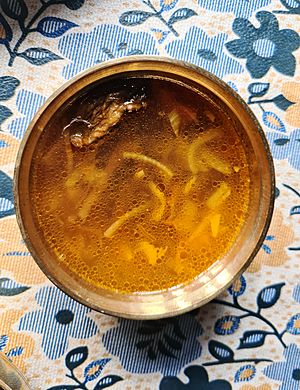Sinki (food) facts for kids

Sinki jhol (Soup)
|
|
| Type | Fermented vegetable |
|---|---|
| Place of origin | Nepal |
| Region or state | Nepal, Darjeeling district, Sikkim, Bhutan |
| Main ingredients | Radish that has been fermented by lactobacillus |
Sinki (Nepali: सिन्की) is a special traditional food from Nepal. It is a type of fermented vegetable, which means it has been changed by tiny living things like bacteria. Sinki is similar to another Nepali food called gundruk. However, gundruk is made from leafy greens, while sinki is made from radish roots.
To make sinki, radish pieces are put into a hole in the ground. This hole is lined with bamboo and straw. Then, the radishes are covered tightly with plants, rocks, wood, and mud. This keeps air out. After about a month, tiny bacteria help the radishes change. This process is called fermentation. Once fermented, the sinki is dried in the sun. This drying helps it last for several years.
Contents
How Sinki is Made
Making sinki is a careful process that has been done for many generations. It starts with fresh radishes.
Getting the Radishes Ready
First, the radishes are left out for a few days to become a bit soft. Then, their leafy tops are cut off. The main root parts of the radish are shredded into small pieces. If there are many radishes, people often use a special tool called a dhiki to break them up. Sometimes, if the sinki will be made into a pickle later, the radishes are just cut into pieces instead of shredded.
The Fermentation Pit
Next, a hole is dug in the ground. This hole is usually about 2 to 3 feet (0.6 to 0.9 meters) deep. Before putting the radishes in, a small fire is lit at the bottom of the hole. This warms up the pit. Once the hole is warm enough, the fire is put out. The bottom of the hole is then lined with bamboo and straw.
Packing and Fermenting
After the pit is ready, the shredded radishes are placed inside. They are pressed down very firmly. More plants, wooden boards, rocks, and mud are used to cover the radishes tightly. This creates a seal that keeps most of the air out. The radishes then ferment for about twenty to thirty days. During this time, special bacteria called lactic acid bacteria do their work.
Drying the Sinki
Finally, after the fermentation is complete, the sinki is taken out of the pit. It is then spread out in the sun to dry. This drying step is very important because it helps to preserve the sinki. Once dried, it can be stored and used for a long time.
How to Enjoy Sinki
Sinki is a versatile food that can be used in different ways.
Sinki Soup (Sinki Jhol)
One popular way to eat sinki is as a simple soup, often called Sinki jhol. To make this soup, the dried sinki is first soaked in water for about 10 minutes. While it soaks, other vegetables like onion, tomato, and chili peppers are chopped. These vegetables are then cooked in a little oil with the drained sinki pieces. A small amount of salt and turmeric powder is added for flavor. Water is then added, and the soup cooks for another 10 minutes until everything is tender. This warm and tangy soup is often served with white rice.
Sinki as a Pickle
Sinki can also be eaten as a pickle. When making sinki for a pickle, it is not dried after fermentation. Instead, the fermented sinki is directly mixed with various spices and then put into bottles. This creates a flavorful and tangy pickle.
Health Benefits of Sinki
Sinki is not just tasty; it is also believed to be good for your health. Many people think it helps with digestion. It is also traditionally used to help with stomach pains and diarrhea.
Sinki in Culture
Sinki is a very important and popular food for Nepali people. This is true whether they live in Nepal or in parts of India like Darjeeling and Sikkim. Just like gundruk, sinki is a part of folk culture. It has even inspired traditional songs and rhymes.

